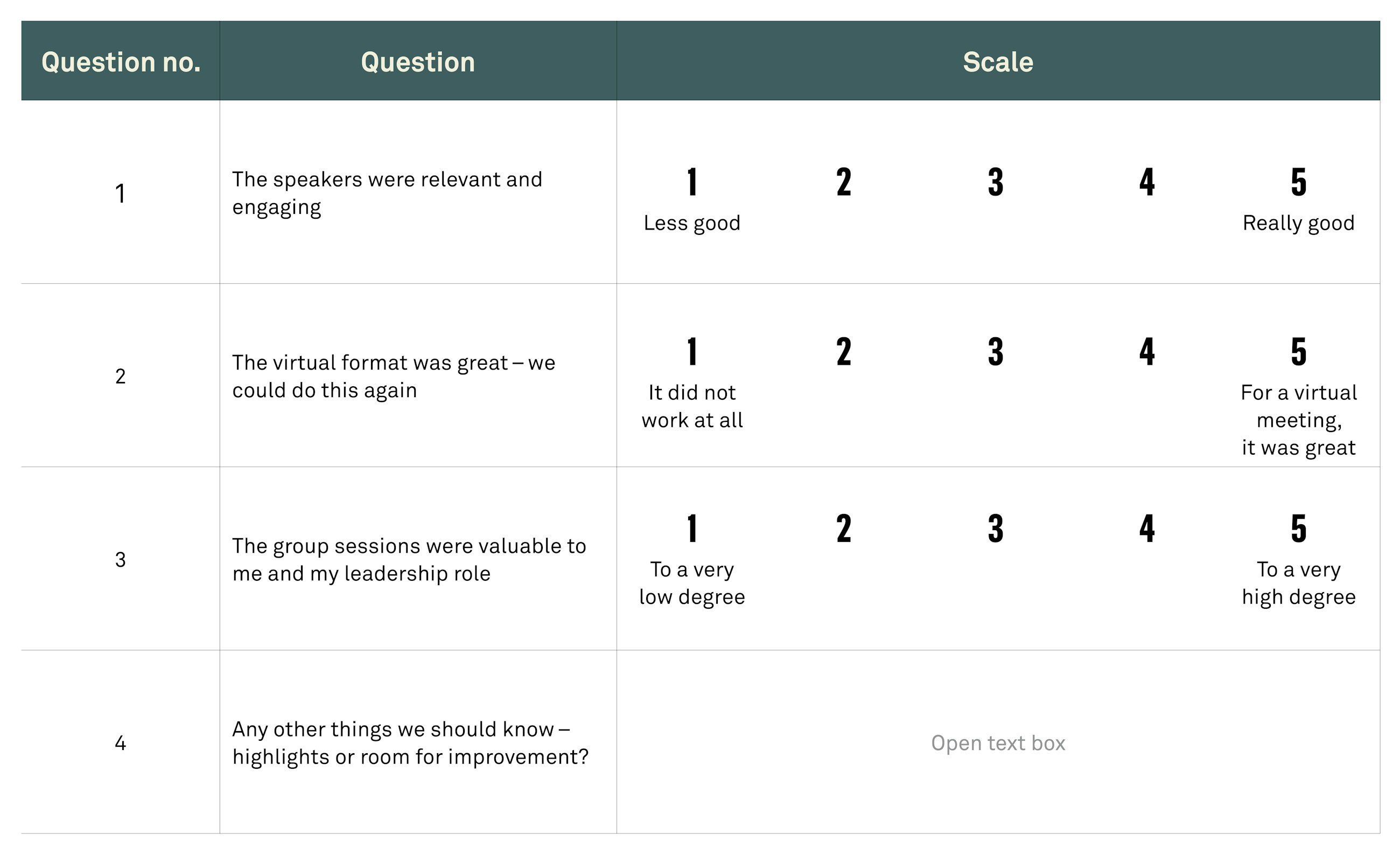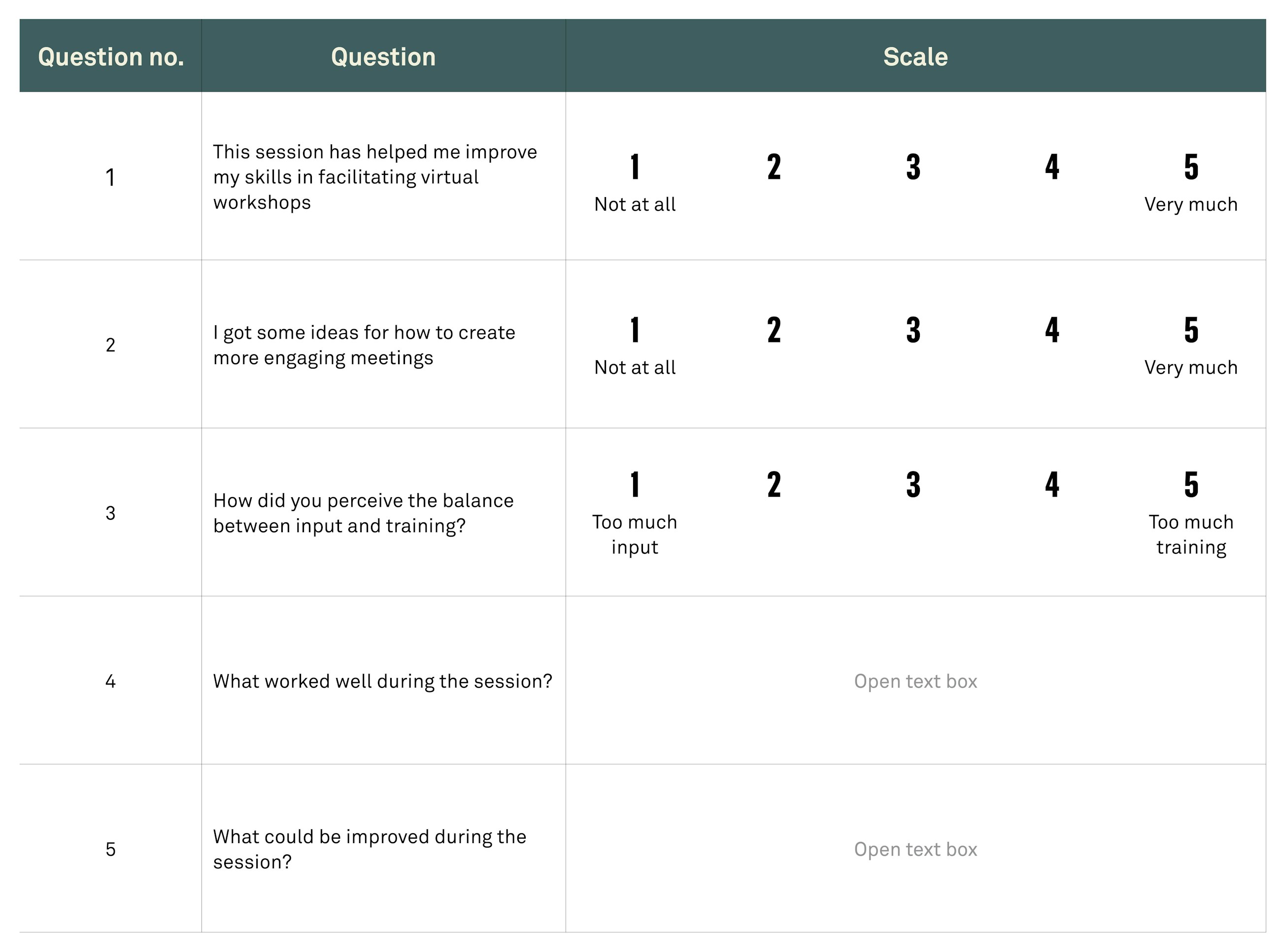Tool
Published
17 November 2020
Use feedback to accelerate learning, improve skills and facilitate meetings with higher engagement and impact.
Have you ever facilitated a session that was less than perfect? We have done so quite a few times. While you facilitate a session – or right after the session – you might get ideas for improvements, and this is your chance to change things that are not working before your next session. However, you may be doing something over and over in your virtual sessions that does not work well for the participants but without you being aware of it. The point is that unless you ask for feedback, you might not learn what to improve to make your sessions more engaging and impactful.
Learning is not a one-time event. It is a constant process, which is why we suggest that you actively use feedback after each session to ensure a strong learning routine and as a way to continuously improve your sessions. You should ask for feedback on yourself as a facilitator and the programme or content that you are presenting.
In our book Virtual facilitation, we have dedicated an entire chapter to the theme of getting feedback, which in our opinion is key to learning and development. In this article, we will focus on how to get feedback from your participants at the end of a session using the chat function or short surveys.
Use feedback to improve your sessions
If we look at feedback models such as the Johari Window or the four stages of competence, they highlight how we as humans have blind spots making us unaware of what others think of us and our competences. Receiving feedback from others is an effective way to open up to your blind spots and become aware of your strengths and areas to improve through the perspectives of others.
We believe that you can use other people’s perspectives to improve your ability to facilitate virtual sessions. Seeing things from other people’s perspectives can help you focus your energy on what and how to improve. This does not mean that you should act upon all the feedback you receive – be open and critical and act upon the things that you find relevant (or the things that you keep hearing over and over again 😉).
Feedback from whom and how?
You can get feedback in many ways. One way is to actively ask for it. You can choose to go “deep” in your feedback, enquiring into how selected participants perceived the session. Using this approach, you get in-depth insights and perspectives from selected people.
If you want feedback on the design of your session, we suggest that you use our model “the design star”. See our text explaining the design star model here.
To get feedback on the way you conducted the session, you may find our model of good virtual facilitation useful. Buy the book Virtual facilitation here.
Another approach is to go “wide”, asking all the participants for feedback at the end of the session. Using this approach, you get an overall perspective or variety of ideas, depending on how you do it. In the following, we will elaborate on what the “wide” approach could look like.
In the “quick and dirty” method, you use the chat to get input from your participants by asking them what they liked and what to improve. This is a fast and efficient way to get input and learn something new. Another way to gather input is by using polls or surveys. When we use polls for feedback, we prefer to do a short one at the end of our virtual meetings using Menti.com or Microsoft Forms. We recommend that you use maximum five questions and add an open text box to the poll where the participants can provide you with specific suggestions – this will also help you become aware of your own blind spots. By using polls or surveys, your participants can remain anonymous compared to using the chat, which can open up for more honest (or critical) feedback.
As mentioned above, we prefer to keep our polls and surveys quite short and do them at the very end of the session. We do this to ensure replies from all the participants – or at least most of them – and to make sure that they have the experience fresh in mind. To do this, you must carefully select a few questions and decide what you want to get feedback on. It is very important that the questions are easy to understand and only focus on one thing. You also need to decide which scale to use. We normally use a scale from 1 to 5, which allows for some nuances and variation, but at the same time it is easy to understand.
Normally, we do not use extensive surveys, even though they would be more valid from a scientific point of view, because we do not want to spend too much time on the survey during the session. We also know from experience that only few people complete the survey after a session, which makes it unreliable in terms of providing a full picture. If you want more insight, we recommend that you ask selected people to spend 15 minutes with you for a short feedback session instead.
Examples of feedback surveys
We have provided a few examples of feedback surveys below. We hope that they will serve as inspiration for using feedback to improve your skills as a virtual facilitator.
Example 1: From a meeting.
Example 2: From a leadership summit.
Example 3: From a training session.
If you want to know more about getting feedback on your virtual sessions, check out our book Virtual facilitation (specifically in the “after” section).
Want to know more?0 3
0
3If you have any questions, please reach out.




